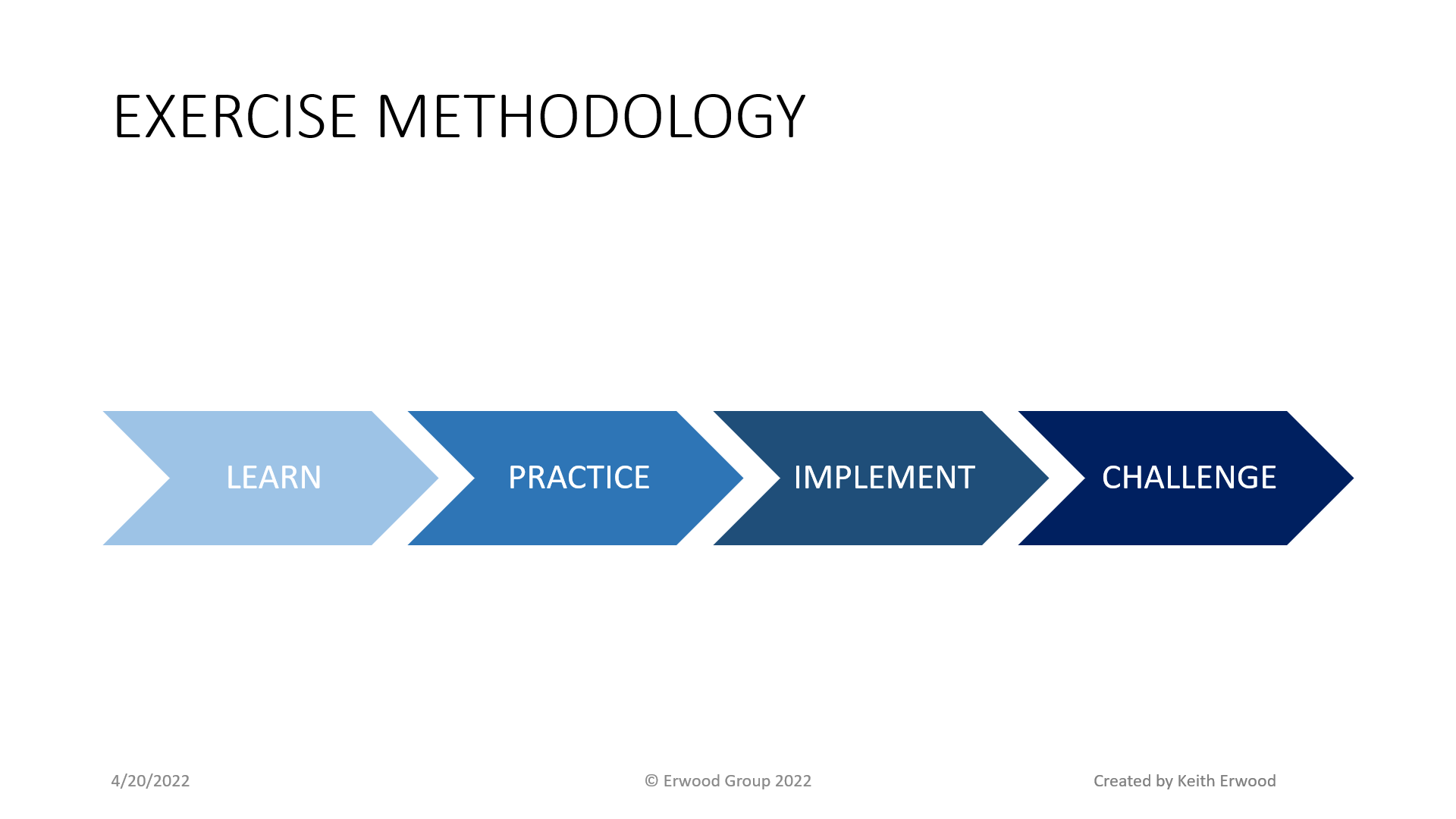
Exercise Methodology: Learn, Practice, Implement, Challenge™
At the Erwood Group, we’ve developed an innovative exercise methodology designed to revolutionize how businesses train and prepare for crises. This Exercise Methodology: Learn, Practice, Implement, Challenge™ is the new Exercise Methodology to Increase Your Business Endurance.
The Problem with the “Crawl, Walk, Run” Methodology
The phrase “crawl, walk, run” is often used in training contexts, but it’s too vague and lacks clear, actionable steps. It doesn’t effectively communicate the goals or the process of progression. That’s why we developed the exercise methodology of Learn, Practice, Implement, Challenge™, which provides a detailed, goal-oriented framework for exercise progression.
Learn
The first stage of this exercise methodology is learning or learn stage. This is where we teach new plan owners and participants about their roles and responsibilities. We ensure everyone understands the plan, where to find it, how to update it, and who is responsible for its maintenance.
We guide participants through each strategy, discussing its validity, potential issues, required dependencies, and possible additional strategies. This stage aims to familiarize everyone with the plan and ensure all necessary details are captured for effective implementation during a crisis.
After each learning exercise, we conduct an after-action review to collect data on lessons learned, what worked, what didn’t, and areas for improvement. This feedback helps refine the plans and prepare for the next stage.
Practice
About a year after the learning stage, we proceed into the practice phase. This stage involves more intense exercises, usually in a tabletop setting. Participants must know how to access their business continuity plans and execute the steps required to activate the plans. In some instances, with more mature clients, we may conduct a brief learning session and move directly into the Practice phase.
The goal is to achieve specific objectives and learn through guided questions or scenarios. This stage allows teams to practice their plans in a safe environment where mistakes are learning opportunities. These practice sessions allow the organization to evaluate recovery strategies and objective timeframes. Multiple practice sessions may be necessary to build comfort and confidence in abilities before moving to the implementation stage.
Implement
The implementation stage involves putting the plans into action during exercises. We test various aspects such as notification systems, strategy execution, vendor coordination, remote working capabilities, failover capabilities and the ability to meet RTO timeframes.
We evaluate the success of these implementations, identify causes of failure, and look for areas of improvement. This stage ensures that all parts of the plan can be effectively implemented and that any issues are addressed, documented, and added to the plan.
Challenge
In the challenge phase, we create scenarios that push the teams to expand their capabilities and build confidence. These exercises are designed to be challenging but achievable, ensuring a positive learning experience without overwhelming the participants.
The goal is to elevate the team’s skills and preparedness, making them ready for real incidents. Unlike some exercise designers who create unrealistic scenarios leading to failure, we focus on providing a constructive environment that encourages learning and growth.
Conclusion
By following the Learn, Practice, Implement, Challenge™ exercise methodology, businesses can improve their preparedness, build confidence in and within their teams, and ensure they are ready for any crisis. Our world-class training and exercises, developed in partnership with an academy award-winning special effects team, offer realistic scenarios in a controlled environment, taking your business endurance to the next level.
Want to learn how our Exercise Methodology: Learn, Practice, Implement, Challenge™ can enhance your resilience and lead to greater Endurance of your business? Click the button and schedule a consultation today.
—
Keith Erwood is the COO & CIO, Co-Founder, and Principal Managing Consultant of the Erwood Group, specializing in business preparedness, continuity, disaster recovery, and crisis management. At the Erwood Group, we help businesses Prepare, Prevent, Protect and Profit through comprehensive planning, mitigation, and exercising. #Endurance>Resilience
Are You Up to the Challenge?
Click the button and take our Business Continuity Challenge
